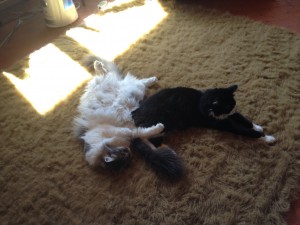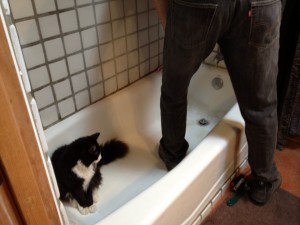 Turns out that Jackson and Isabel went behind my back to talk to Meankitty. You can read the interview here.
Turns out that Jackson and Isabel went behind my back to talk to Meankitty. You can read the interview here.
How to Balance Chores and Deadlines
 I’m over at Word Whores today, talking about how we divide labor in my house when deadlines loom.
I’m over at Word Whores today, talking about how we divide labor in my house when deadlines loom.

The Mark of the Tala

Thunder on the Battlefield, Vol. II
What to Do When You’re Accidentally Invited to a Party
 I recently changed my laptop background to this pic I took in Virgin Gorda. I might have to take it down again, because it’s making me all kinds of wistful.
I recently changed my laptop background to this pic I took in Virgin Gorda. I might have to take it down again, because it’s making me all kinds of wistful.
The other night, I had a few neighbor gals over for wine and snacks. I know for a lot of you out there, this is a no-brainer thing, right? Some of you have guests over all the time, willy-nilly, tra-la tra-lay. Yeah, I know about you people. I used to be like you.
These days, though, having people over means cleaning the house, which I no longer pay someone ELSE to do. Those were happy days. It means acquiring snacky food that I no longer keep around the house and also cleaning MYSELF up. Yes – I confess that, working from home and not seeing anyone but David or people at the gym, I am not company-ready a great deal of the time.
So, when the day came, by lunchtime I bitterly regretted that I’d invited these people to my house. I may have even contemplated calling them and saying I was sick. If I’d had a job outside the house, I would have gotten everything done the night before, then whizzed home from work, in my cute work outfit with my hair and make-up already done, thrown some snacks onto platters and been done.
But no.
Instead I had to halt the day job and go to the store, vacuum and, gasp, shower and assemble myself. I griped to David that probably no one would come and then all that effort would be WASTED. He says, well, we can always have a party together.
I tactfully did not point out that he’s blown his gig by loving me without make-up and a cute outfit.
Still and all, people came and I had fun. It was totally worth it and now I feel all bubbly and optimistic that I could muster to do this Much More Often. An ambition I’ll likely come to regret in the future when I have guests LOOMING again.
For now, however, I’ve paid several people back for previous hospitality and created hostess-debt in a few others. So they get to muster the effort now and have us over, which is always preferable. I’m always happy to drink someone else’s wine and have at their snacks. Totally worth make-up for that. (Maybe someone should tip-off David.)
In fact, David and I once went to a party we were accidentally invited to.
No, really. I got this email invitation to “Jennifer,” which is a sure sign that the person doesn’t actually know me. With the possible exception of IRS agents and they, notably, never invite me to parties. Especially not Halloween costume parties where we’re encouraged to come as our alter-egos. Fun, right?
But I totally didn’t know the people who invited us. Neither did David. I asked around and none of my friends knew them either. Finally I found one couple that we occasionally socialized with – neighbors a few blocks away, he was a nonfiction writer I’d been on panels with and she and I had intersected in various social groups – who had also been invited. They agreed that the people having the party couldn’t possibly know us.
I suspect it was the “Jennifer” syndrome. See there are so damn many of us that the email autofill function is like a curse for anyone who knows more than one Jennifer. Which is everybody, right? It’s like that movie “Jennifer 5” or some such from the 80s where she discovers she’s a clone. It’s annoying, but there’s also a certain solidarity in our Jenniferness.
So, yes – we totally went to the party.
And I asked the host and hostess if they meant to invite us. This may have been complicated by the fact that I was wearing thick faerie queen makeup and David was dressed up as an early-days Jim Morrison. We finally established that, no, we didn’t know each other.
They let us stay, however, and the party really did rock. Like I always suspect the parties I’m not invited to do.
I reciprocated, too – by inviting them to our annual Christmas party. I even wrote on the invitation that we were the people they didn’t know, who’d crashed their Halloween party.
They didn’t come. Can you believe it?
Totally worth the make-up though.
Why Writers Shouldn’t Pay Attention to Pet Peeves and Cranky Lists
 The last week was so warm, everything is leafing out and the lilacs are budding. Today we’re wrestling with a storm that slid down from Alaska (gee, thanks, Alaska) and we’re to get a hard freeze tonight. Yeah, I’ll be out there this afternoon, making free with the blankets.
The last week was so warm, everything is leafing out and the lilacs are budding. Today we’re wrestling with a storm that slid down from Alaska (gee, thanks, Alaska) and we’re to get a hard freeze tonight. Yeah, I’ll be out there this afternoon, making free with the blankets.
I feel like lately I’ve been seeing lots of pet peeves in social media. Editors and agents like to tweet their peeves, often with the hashtag #pubtip. Sometimes a literary agency will start a conversation on the topic – “Hey readers, what are your literary pet peeves?” Bloggers will make lists of cliches to avoid.
All of these are great conversation starters on social media. After all, people love to air their gripes with each other, especially in a humorous context. It’s even better if those gripes derive from your work – the things you deal with all day, every day, week after week. They make for great riffs and people one-up each other and add gifs. It can be terrific entertainment.
I’ve even heard it said that you should follow agents and editors you’d like to work with, so you know what their peeves are.
No, no, no.
Seriously. Don’t do it. Don’t pay attention to these gripes and lists.
Why? Because they’re not really real.
Let me give you an example. A few weeks back I saw an agent tweet something along these lines:
“Pet peeve: books that open on dialogue. Voices shouldn’t come before we know who the bodies are. #pubtip”
This struck me because I’ve done this with published works. More than once. I bet we can all think of books that have done this and done it really well. This agent is right to call it a pet peeve – it’s nothing more than something that personally irritates her. So, should you change your book opening to please her?
Let’s consider that. Maybe you’re saying, sure Jeffe, if I’m querying her, I want my best odds, so for her I’ll open on description instead. Okay, fine, but she’s one of hundreds of agents you might query, with no guarantee that, just because you avoided that particular gripe of hers, she’ll want to represent you. So do you change your opening for every agent you query? Do you scour the internet and make a spreadsheet of every complaint every agent or editor makes, maybe categorized by type – openings, endings, characters, plot devices – and then check them off to groom them for that person?
Please tell me you wouldn’t do this.
There’s a fable for this, which everyone should recall, about the man who tried to please everyone. This is kind of a cutesy version, but the message remains – when you try to please everybody, you end up pleasing nobody. Least of all yourself.
The thing to keep in mind is when these fine people – and I’ve seen my agent and editors, who I like and admire, do this – give advice, they’re seeing the world from their perspective. I know that seems self-evident, but stick with me. I think of this like the teacher with 30 students. They learn her name immediately. It takes her much longer to learn 30 names. An editor wants a manuscript that’s tailored to him. He’s not seeing the writer’s perspective of trying to assimilate the likes and dislikes of 30 editors. And really, it’s not his problem.
So, what’s the solution?
Three things: Be true to yourself, learn your craft and protect yourself from negativity.
Being true to yourself
See, even if you change your opening so cranky agent who doesn’t like disembodied dialogue openings will keep reading, she might also hate your second line. Or the fact that your main character is gay. Or that she isn’t gay. Reading is subjective. Either the agent will resonate with your work or she won’t. It’s tempting to try to control this, but you can’t. The sooner you accept that, the happier you’ll be. And I’ll let you in on a little secret – even if she hates that you started on dialogue, if she loves the rest of the story, she’ll still take it. She might call, gush about your wonderful story, offer representation and then say “oh, but I think you should open with this line.”
The one thing that will surely kill a story, however, is if it’s been worked to death to please everyone but yourself. It’s like the old saw that no one will love you until you love yourself first. If you don’t love your story, how do you expect someone else will?
Do what’s right for the story, first and foremost.
Learn your craft
Most of the cranky lists – things like “cliches writers should avoid” or “10 signs of bad writing” – are responses to poor craft. I saw one yesterday, that both my agent and one of my editors were all over with glee, that listed cliches. They each listed which ones they particularly hate. The thing is, I figured I’d probably done all of those things. For example, one was don’t have your character describe themselves in a mirror. I use mirror a lot. I’m really interested in the idea of self-perception and that the mirror is an archetype of being able to see your true self. I know perfectly well if I pointed this out to my editor or agent, where in my books I’ve done this, they’d say “oh, but you avoided the cliche – you handled it differently.”
Thus, the answer is not truly to avoid cliches. That’s the simplistic approach. After all, cliches become cliches for a reason (also a cliche, right there). They get overused. The point is to use those memes or archetypes well enough that they transcend cliche instead of being a crutch.
That’s craft.
Protect yourself from negativity
To me, this is the hugest part. When I saw my agent and editor climb all over that list of cliches, my brain started churning and obsessing. How many of those have I done? Oh my god, isn’t that one in the story I just sent her? I started thinking about the story I’m writing now and wondering if I need to rework this or that. I worried. I felt like a Bad Writer. Even that one about not opening with disembodied dialogue niggled at me, even though the story I know I did it in has been used in workshops with that opening as a good example. That’s a lot of emotional impact on me, for something she likely Tweeted in a moment of irritation and promptly forgot.
See, when people post this stuff, they’re thinking about engagement. They’re enjoying sharing gripes with fellow professionals. They’re not thinking about the creator of the art who might be derailed by what is essentially, to them, cocktail party conversation. It’s not that its bad advice, necessarily, but they’re not thinking about how they’re saying it.
All of this is why I think writers shouldn’t pay attention to this kind of thing. I’m not saying don’t follow agents and editors you’re interested in. I absolutely think you should. But don’t treat everything they say as gospel. Who knows? By the next day they may have forgotten they even said it.
Now go write.
Jeffe’s Spotlight on Ellora’s Cave
 I’m over at Word Whores today, talking about my experiences with e-publisher Ellora’s Cave.
I’m over at Word Whores today, talking about my experiences with e-publisher Ellora’s Cave.
How Important Is Likability in Characters?
Yes, Jackson has discovered the Great Outdoors. And it is Good.
We watched an interesting movie last night, Tanner Hall. It’s a mediocre movie from 2009 with nobody particularly compelling in it. The ending however, is very nearly incandescent. And yes – you really have to watch the whole movie to get the ending. It truly arises out of the story in a way I didn’t expect.
It explored a theme I don’t see treated directly in stories very often. About forgiveness and likability. It’s about knowing someone has behaved badly and… letting it go.
There’s this old saw that we dislike in other people those things that we dislike in ourselves. I don’t know how true this is – or if there are any psychological studies to support it. I’ve experienced bosses who suspected me of cheating on things like time-reporting in the ways that I *knew* they did. I also know that I dislike in other people qualities that I’ve worked hard to eradicate in myself, such as narrow-mindedness, intolerance, lack of compassion.
I suspect that, in real life, our reasons for not liking some people are usually not well-examined and probably don’t have good foundations. A lot of the time jealousy plays in. Or that the person doesn’t do things the way we want them to. Or just plain irritation. The cases where we don’t like a person because they’ve actually done us an injury are probably in the minority.
But this is not true in fiction, right?
In the world of fiction, we feel very free not to like characters. In fact, we’re encouraged to outright hate the “villains” in a way that we’re simply not socially allowed to in real life. We also get to dislike the heroes and heroines of the stories.
This is something that comes up in romance All The Time. Whether or not the heroine is “likable” can be the key to whether or not the reader enjoys the whole story. I see debates all the time about whether heroines are likable for this or that reason. Now, typically the readers are female and the heroine functions as an avatar of sorts for them in the story. So, if the heroine behaves in a way that they judge to be wrong, it annoys them.
One romance writer who gets this reaction a lot is Victoria Dahl. I enjoy her books because her heroines feel so real – like a contemporary woman who might be my friend. And, like real women, they have flaws. They annoy their families. They have sexual histories. In one of my favorites, Talk Me Down (you might have to scroll down the page to find it – I have SPOKEN to Ms. Dahl about this), the heroine acted out sexually when she was younger.
And, boy, how the readers judged her for that.
It’s a funny thing about romance – somehow we all still see ourselves as these virtuous virgin feminine ideals. Even though, in real life, we’d never agree to that ideal.
Watching that movie last night made me think of my grandfather. He was an admirable man in many ways – raised himself up out of nothing, educated himself, became a wealthy man, then lost it all again. Alcoholism played a role in that. And hubris. He was unfaithful to my grandmother – a woman who’d first been his mistress – and ultimately left her for another long-time mistress. My mother and my aunts carry a lot of bitterness and anger for how he affected their lives. I remember him for giving me my copy of Omar Khayyam, teaching me to draw and for long walks after dinner when we talked about Interesting Things.
Is he likable? Probably not. In some ways, maybe, but if we reduced his life to a scorecard, he’d probably end up in the negative column. At the end of his story, though, I find that none of that matters to me.
I love and forgive him, anyway.
Maybe that’s what we mean, when we talk about redeeming a character. Good characters, like real people, have flaws. There’s no story if they don’t have something to overcome.
I suppose that’s true for us all.
Public book signing at the Lori Foster Reader & Author Get Together
Come find me at the book signing at the Lori Foster Reader & Author Get Together!
Public book signing at the Lori Foster Reader & Author Get Together
Saturday, June 8th, 2:00 to 4:00
Cincinnati Marriott North
6189 Muhlhauser Road
West Chester, OH 45069
Nourishing Creativity – an Ode to Polton Elementary School and My Mother
 With the Phantom book finished, I spent time in the garden this weekend. Most restorative to work with my hands and body, to clear away the old detritus, coax the perennials into shape and plant new flowers. And clean up the gargoyle. She’s watching over the pansies for me.
With the Phantom book finished, I spent time in the garden this weekend. Most restorative to work with my hands and body, to clear away the old detritus, coax the perennials into shape and plant new flowers. And clean up the gargoyle. She’s watching over the pansies for me.
And, as of yesterday, I started in on developmental edits for Rogue’s Possession. For those who aren’t familiar with the lingo, those are the first round of edits. My editor just sends me an email describing some global changes she’s looking for. Add tension to the beginning, tighten the ending. Here are some suggestions. That sort of thing. Some of you may recall she’d originally asked for April 3 on those (dies laughing), but now we’re trying for April 15. I think I can do that.
My mom complains that I make my childhood sound awful when I reflect on my growing up. I suspect this is because our painful experiences are the ones that really spur us to change – or, at least, that’s how we remember it.
Yesterday one of my crit partners sent me the TED talk by Elizabeth Gilbert on the creative spark. You might remember it from early 2009, when it was really making the rounds on the internet. My friend, however, must have been under a rock at the time and missed it. The talk really resonated with her – as it did for many of us – and I watched it again, to be able to discuss some of the finer points. Surprising to me: I heard very different things in it this time, after dedicating so much of the last four years to my own writing.
My friend had come across the talk because I’d sent her this one, by Ken Robinson on how schools kill creativity. One story he tells is about Gillian Lynne, who was failing out of school at age 8 – until her principal recognized that she was a natural dancer. Her mother sent her to dance school instead, and Gillian became a success instead of an academic failure. My friend asked me if I thought my schooling had killed or nurtured my creativity.
Something I’d never once thought about.
I mean, I’ve mentioned my early schooling from time to time. How I went to an experimental school in the early 70s, with team teaching, no desks and open space classrooms. Mostly I have made fun of it (Magic Circle where we shared our feelings) or criticized it (the famous ordeal of my stepfather having to teach me the multiplication tables because I’d been pulled out into a special program and then plunged back into long division without knowing how to multiply). My stepfather was a vice-principal in a neighboring school district that was not experimental and he often complained about the gaps in my traditional education.
But thinking back now… wow.
That special program that caused me to miss multiplication? (Which, by the way, took less than a week for me to make up.) I spent that third grade year with fourth, fifth and sixth graders, traveling around Colorado and learning about western history. Now I realize how much that year opened my mind to the range of human experience. Women like Baby Doe Tabor and Molly Brown became larger than life to me. That time instilled in me an appreciation for the concept of the frontier, of struggle, of the desire for wealth and success and the crushing effects of defeat.
My teachers were good to me at that school. They let me read in class when I was bored with the assignment. They gave me special projects to work on. Instead of smacking me down for being a smart ass (because, oh yes, I was one even then), they encouraged me to channel that energy. I found it funny, often, that they were always concerned that I not get bored, but now I see – I was never bored. My teachers found ways to challenge, stimulate and open my mind.
And my creativity.
I sometimes joke that I have such an eclectic approach to life. In college I double-majored in biology and religious studies, with enough credits to minor in theater. I ended up in grad school for neurophysiology, work as an environmental consultant and now write fantasy and romance novels.
I’m realizing now that this is their gift to me. That my early schooling did nourish my creativity. My mom bought a house near this school so I could go there and it made an amazing difference for me.
What a wonderful gift this was.
